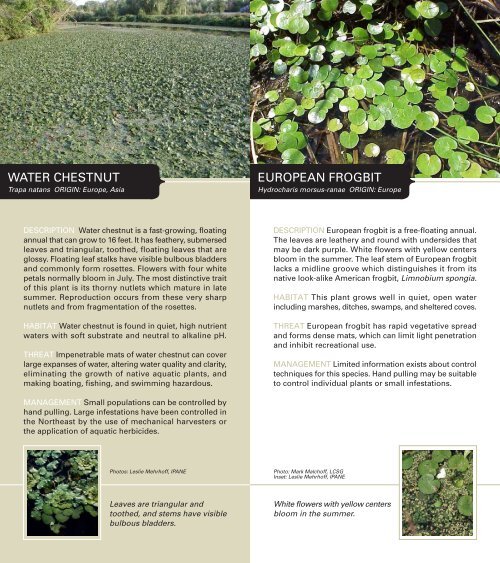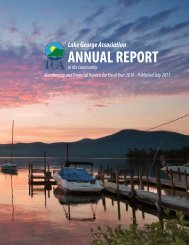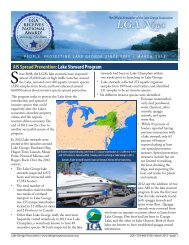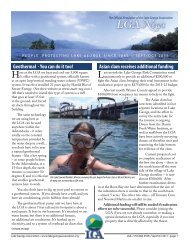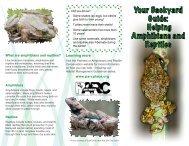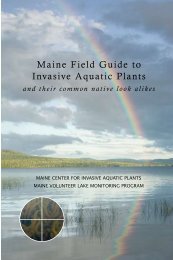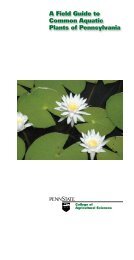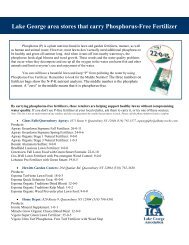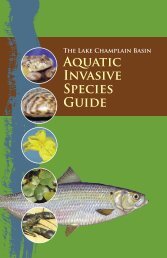Invasive Plants of the Adirondacks - Adirondack Park Invasive Plant ...
Invasive Plants of the Adirondacks - Adirondack Park Invasive Plant ...
Invasive Plants of the Adirondacks - Adirondack Park Invasive Plant ...
Create successful ePaper yourself
Turn your PDF publications into a flip-book with our unique Google optimized e-Paper software.
WATER CHESTNUT<br />
Trapa natans ORIGIN: Europe, Asia<br />
EUROPEAN FROGBIT<br />
Hydrocharis morsus-ranae ORIGIN: Europe<br />
DESCRIPTION Water chestnut is a fast-growing, floating<br />
annual that can grow to 16 feet. It has fea<strong>the</strong>ry, submersed<br />
leaves and triangular, too<strong>the</strong>d, floating leaves that are<br />
glossy. Floating leaf stalks have visible bulbous bladders<br />
and commonly form rosettes. Flowers with four white<br />
petals normally bloom in July. The most distinctive trait<br />
<strong>of</strong> this plant is its thorny nutlets which mature in late<br />
summer. Reproduction occurs from <strong>the</strong>se very sharp<br />
nutlets and from fragmentation <strong>of</strong> <strong>the</strong> rosettes.<br />
HABITAT Water chestnut is found in quiet, high nutrient<br />
waters with s<strong>of</strong>t substrate and neutral to alkaline pH.<br />
THREAT Impenetrable mats <strong>of</strong> water chestnut can cover<br />
large expanses <strong>of</strong> water, altering water quality and clarity,<br />
eliminating <strong>the</strong> growth <strong>of</strong> native aquatic plants, and<br />
making boating, fishing, and swimming hazardous.<br />
DESCRIPTION European frogbit is a free-floating annual.<br />
The leaves are lea<strong>the</strong>ry and round with undersides that<br />
may be dark purple. White flowers with yellow centers<br />
bloom in <strong>the</strong> summer. The leaf stem <strong>of</strong> European frogbit<br />
lacks a midline groove which distinguishes it from its<br />
native look-alike American frogbit, Limnobium spongia.<br />
HABITAT This plant grows well in quiet, open water<br />
including marshes, ditches, swamps, and sheltered coves.<br />
THREAT European frogbit has rapid vegetative spread<br />
and forms dense mats, which can limit light penetration<br />
and inhibit recreational use.<br />
MANAGEMENT Limited information exists about control<br />
techniques for this species. Hand pulling may be suitable<br />
to control individual plants or small infestations.<br />
MANAGEMENT Small populations can be controlled by<br />
hand pulling. Large infestations have been controlled in<br />
<strong>the</strong> Nor<strong>the</strong>ast by <strong>the</strong> use <strong>of</strong> mechanical harvesters or<br />
<strong>the</strong> application <strong>of</strong> aquatic herbicides.<br />
Photos: Leslie Mehrh<strong>of</strong>f, IPANE<br />
Photo: Mark Malch<strong>of</strong>f, LCSG<br />
Inset: Leslie Mehrh<strong>of</strong>f, IPANE<br />
Leaves are triangular and<br />
too<strong>the</strong>d, and stems have visible<br />
bulbous bladders.<br />
White flowers with yellow centers<br />
bloom in <strong>the</strong> summer.


